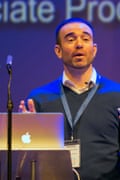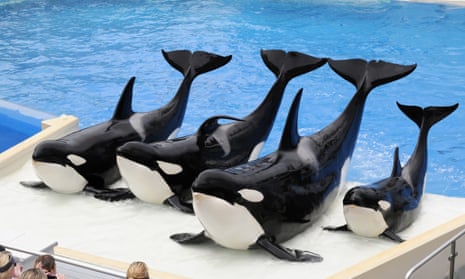John Hargrove can clearly recall the moment in 1980 when, as a wide-eyed six-year-old sitting with his family in the audience at a SeaWorld show in Orlando, he fell in love with killer whales. Harder to pinpoint is when his relationship with his dream job, training orcas for the theme park giant, finally turned sour.
It began with little things he says he started to notice about how SeaWorld treated its captive sea lions, dolphins and whales, and the trainers who would showcase them to the public. He says he saw cramped holding pools he believes were filled with too much chlorine; animals going blind or developing arthritis prematurely; and senior trainers banished from working with their beloved whales because they dared to speak out.
Later in his 14-year career, which is chronicled in his new book, Beneath the Surface: Killer Whales, SeaWorld, and the Truth Beyond Blackfish, he says he witnessed incidents that broke his heart: whales becoming aggressive towards trainers because of frustration at being confined in tiny pens for hours on end, or the anguished cries of whale calves forcibly separated from distressed mothers, against SeaWorld’s stated policy.
Then, just 60 days apart, came the deaths of two friends and fellow trainers, Alexis Martinez and Dawn Brancheau, both killed by whales owned by SeaWorld.
The death in Spain of Martinez, in the jaws of a 14-year-old male named Keto on loan to Tenerife’s Loro Parque, alarmed Hargrove and his fellow trainers, he says, not least because it was presented as a tragic drowning before the autopsy report revealed the extent of the violence Keto had inflicted.
But when Brancheau was killed horrifically in February 2010, her body torn apart by an adult male named Tilikum at a public dinner show at SeaWorld Orlando, the company came under unprecedented scrutiny over its policies and safety procedures, leading to a $75,000 citation from the Occupational Safety and Health Administration and a ban on trainers working with whales in water.
Meanwhile, SeaWorld’s attendances, earnings and share price have slumped. It has appointed a new chief executive and launched a major public relations offensive, designed to counter the fallout from the highly critical 2013 documentary Blackfish, which looked into Brancheau’s death.
As for Hargrove, it was the deaths of his friends, he tells the Guardian, which probably tipped the balance. The trainer, who details his own near-fatal encounter with an aggressive whale called Freya in the opening pages of his book, weighed everything up and decided, in August 2012, that it was time to quit.
Yet the man who is now one of the company’s most vocal critics says that for years, following the day in 1993 when he started as enthusiastic young apprentice cleaning out buckets at SeaWorld’s San Antonio park, he firmly believed he was working for the good of the animals.
“It took a while,” he says. “You had to learn what was healthy and unhealthy, what was normal and abnormal, because you don’t know in the beginning. They taught us and we spouted it to the public.
“Then the company would make these decisions to strip calves away from their mothers and you would look at them in a different light as they tried to explain it away. They’d say it has to be this way and this is the reason why, and you’d truly believe it; then they’d change their story.
“When there was a need, the protocols changed, the rules changed. You start to see cracks in the armour, and eventually it registers: this is not normal, this is not right.”

SeaWorld accuses Hargrove of sensationalism. “We do not separate killer whale moms and calves, and in the rare occurrences that we do move whales among our parks, we do so only in order to maintain a healthy social structure,” says a rebuttal on its website seaworldcares.com.
Chuck Tompkins, SeaWorld’s curator of zoological operations, said Hargrove was mistaken to say the whales were distressed. “We’ve trained them to be relaxed during that move,” he told NPR in a recent interview. “To say that they’re uncomfortable or stressed, that’s just not the way we do our business.”
But Hargrove is adamant that he is aware of at least 19 calves being separated from their mothers, and says any dissent is quickly quashed by SeaWorld’s “cult-like” attitude.
“The way that it works is you keep your mouth shut. If you don’t, there’s a price to pay,” he says, adding that punitive measures include being moved out of the whale stadium or, if a trainer leaves SeaWorld on bad terms, being blacklisted.
Hargrove admits that his resignation was partly caused by his physical condition. Years of working with the whales in the water left him with a “laundry list” of injuries including broken ribs, fingers and toes, serious sinus issues and wrecked cartilage. “For the last three years, my doctor was telling me I needed to quit now,” he says.
Ultimately, though, he says he stayed on because of his “spiritual connection” to the whales, and his mistaken belief that he could improve their circumstances.
“I’m conflicted about my career because I have memories I’ll cherish for the rest of my life, memories that most people never have the opportunity to have. These whales gave me my childhood dream,” he says.
“But I was also part of a system that did this to those animals. I was the one treating sunburns because their skins were drying out because they were lying motionless on the surface of the water with no shade for hours, and on and on.
“I was able to leave and go on with my life, and they’re not. For everything they gave me, the least that I can do is take some criticism from boardroom cowards, the SeaWorld people sat behind a keyboard; weather that storm, and go out there and tell the truth.
“I was a killer whale trainer for 14 years and this is what I saw, the good and the bad.”
- Beneath the Surface: Killer Whales, SeaWorld, and the Truth Beyond Blackfish, by John Hargrove with Howard Chua-Eoan, is published by Palgrave Macmillan Trade.

Comments (…)
Sign in or create your Guardian account to join the discussion